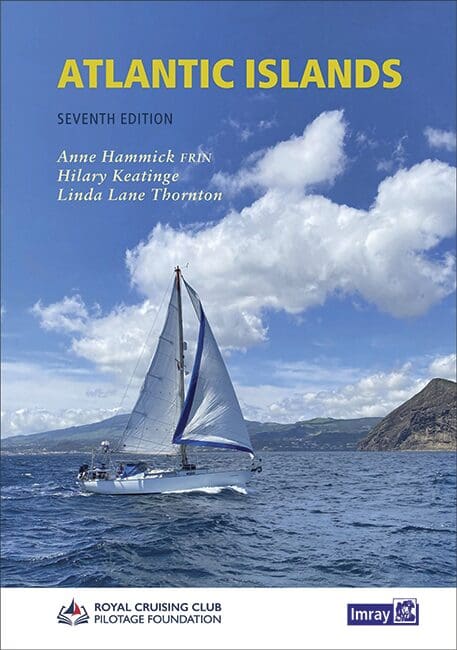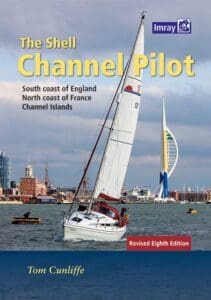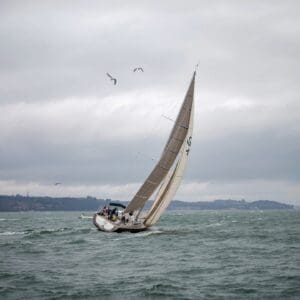For any sailor planning a voyage from the UK to the Azores, Canaries, Madeira, Cape Verde, or even across the pond to Bermuda, Atlantic Islands is a name that comes up again and again. And rightly so. This is a cruising guide that’s been relied upon by generations of offshore skippers—and the latest edition only strengthens that trust.
In this review, we take a close look at what makes the 7th edition of Atlantic Islands an essential for British sailors, from its comprehensive coverage to the confident tone that makes it feel like having an experienced friend aboard.
A Heritage of Authority—Refreshed for a New Era
Originally compiled by Anne Hammick, a seasoned sailor and respected figure in the Royal Cruising Club Pilotage Foundation (RCCPF), the pilot book has long served as a benchmark for Atlantic cruising. Subsequent editions have added new contributors with specific local knowledge—none more so than Linda Lane Thornton, who brings decades of Azorean sailing experience into the mix. With Hilary Keatinge’s steady editorial hand, the 7th edition is both authoritative and refreshingly readable.
This is no dry manual. The authors write with calm confidence, seasoned by experience, and balanced by a practical understanding of what sailors truly need—especially when landfalls are few and far between.
What It Covers—and Who It’s For
The guide spans:
- The Azores
- Madeira and Porto Santo
- The Canary Islands
- The Cape Verde Archipelago
- Bermuda
Each archipelago is given in-depth treatment. The book provides:
- Navigation notes, hazards, prevailing winds, tides
- Harbour plans and anchorage descriptions
- Customs and immigration procedures
- Contacts for marinas and local agents
- Provisions, water, fuel, repairs, and local services
- Cultural and historical highlights for shore time
It’s not written for first-time sailors, but for confident coastal or offshore skippers aged 35–60 with ambitions beyond familiar UK waters. The guide is particularly valuable for those planning:
- A cruising sabbatical through the Atlantic islands
- An ARC or independent transatlantic crossing
- Seasonal migration to the Mediterranean or Caribbean
- Voyages with long stays in the Azores, Madeira or Canaries
Navigational Detail Where It Matters
What sets this guide apart from a standard almanac is the precision of its navigation content. Each harbour and anchorage includes:
- A clearly annotated chartlet (often based on official sources with updates)
- Pilotage notes for day/night entry
- Cautions for underwater hazards or shifting sandbars
- Approach bearings and local radio channels
Unlike some guides that copy-and-paste Navionics info with little commentary, Atlantic Islands Pilot offers real-world advice gained by skippers who have made the approaches themselves.
For example, the guide’s entry on Horta (Faial, Azores) discusses not just the marina layout, but how to avoid confusion when arriving at night after a 1,200nm passage—and how to handle the formalities without delay. That kind of sailor-to-sailor insight is priceless.
Island-by-Island Highlights
Azores
The crown jewel for many Atlantic cruisers. Linda Lane Thornton’s contributions here are excellent. She explains micro-climates between islands, ferry links for shore crew, haul-out options, and provisioning notes in small towns that larger guides often miss.
Madeira & Porto Santo
From the historic Funchal waterfront to the peaceful Porto Santo anchorages, this section balances navigational guidance with local context—such as advice on the Porto Santo marina dredging schedule, and tips for getting gas bottles refilled.
Canary Islands
The Canaries get thorough coverage, with island-by-island marina details and explanations of the regional weather patterns (including the famed acceleration zones). With more British boats wintering here each year, this section is especially useful.
Cape Verde
Often under-described in older publications, Cape Verde is given an honest, practical overview—highlighting safe anchorages, realistic expectations for provisioning, and bureaucratic steps that are more variable than in EU territories.
Bermuda
Though fewer UK cruisers stop here today due to routing changes, the Bermuda section remains relevant for those doing traditional passages from the Caribbean to the Azores or US East Coast. Hammick’s careful notes on approach channels, reef gaps, and customs formalities are still spot on.
Strengths
- ✅ Clear Harbour Plans: Each chartlet is easy to read and usually paired with real-world photo references.
- ✅ Up-to-Date Info: The RCCPF’s 2021 update reflects the latest marina expansions, paperwork changes, and contact details.
- ✅ Relaxed Yet Authoritative Tone: The authors don’t just instruct—they explain the “why” behind each recommendation.
- ✅ Beautiful Full-Colour Layout: High-quality images, good paper stock, and margin notes make it easy to use onboard.
- ✅ Cultural Notes: The inclusion of local customs, language tips, and regional cuisine brings the islands to life beyond the chartplotter.
Limitations
- ❌ Size & Weight: At 444 pages, it’s a big hardback—ideal for planning, less so for the cockpit. Pair it with waterproof waypoints or notes.
- ❌ No Digital Version (yet): There’s currently no eBook or app version, so you’ll want to handle this with care if space or moisture is a concern.
- ❌ Not for Beginners: Assumes a working knowledge of passage planning, offshore procedures, and boat handling in unfamiliar ports.
How It Compares
Versus other guides—like Reeds Atlantic Europe or Mediterranean Almanac—Atlantic Islands Pilot is more geographically focused and offers deeper insights into each destination. Reeds is excellent for passage timing and weather, but lacks the pilotage depth and local colour this guide provides.
Compared with online-only sources like Noonsite, the book delivers consistently verified, structured guidance—no guesswork, no contradictory updates.
The Verdict: Essential for Atlantic Cruisers
If your sailing ambitions include hopping down the Atlantic arc, preparing for the ARC, or simply slow cruising through the volcanic beauty of the Azores or Cape Verde, then this is the pilot book to own.
It’s a reference you’ll turn to again and again—during route planning in your UK marina, for landfall briefings mid-passage, and even when sipping vinho verde in a sleepy Portuguese harbour café.
For UK sailors aged 35–60 who value clarity, experience, and comprehensive detail, Atlantic Islands Pilot is a must-have.
Rating: ⭐⭐⭐⭐⭐ (5/5)
Essential. Authoritative. Practical. A sailor’s pilot book through and through.


